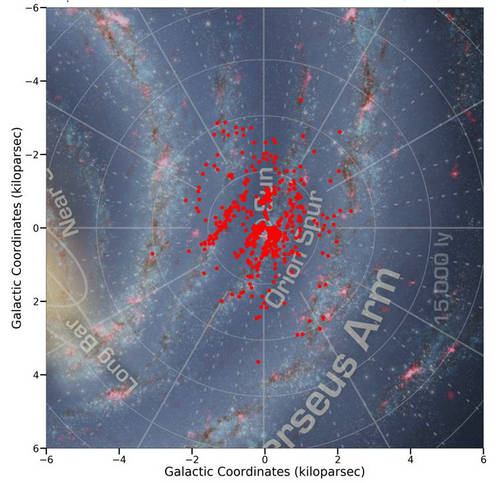The first large catalogue of molecular clouds in the Galactic plane with accurate distances
Recently, Associate Profs Bingqiu Chen and Guangxing Li, together with Prof. Xiaowei Liu, from South-Western Institute for Astronomy Research of Yunnan University have published the first large catalogue of molecular clouds in the Galactic plane with accurate distances. The results have been published in the Monthly Notices of the Royal Astronomical Society.
Most molecular gas in our Galaxy is contained in molecular clouds, where star formation occurs. The main component of molecular clouds is molecular hydrogen, while they also contain very small amounts of other molecules, such as carbon monoxide molecules and interstellar dust. Molecular clouds are cold, with the temperature of about -250 degree Celsius. They are also giant, with the typical size of more than 100 light years and the typical mass of about 100,000 solar masses.
Molecular clouds are mainly distributed in the Galactic plane. There are about thousands of molecular clouds in our Galaxy. The formation of molecular clouds and the birth of stars are key processes in the life cycle of galaxies. Understanding the physical properties of molecular clouds and their spatial distribution is thus of great importance, where estimations of molecular cloud distances are crucial.
However, building a large sample of molecular clouds with accurate distance estimates is a difficult task. The conventional kinematic distances always suffer from large and inhomogeneous uncertainties which could reach 30% - 50%. Hitherto only a few nearby well-studied molecular clouds at low latitudes have accurate distance estimates.
Taking advantage of the three-dimensional interstellar dust map in the Galactic disk, which was constructed by the authors based on the photometry from Gaia DR2, 2MASS and WISE and the spectroscopic data from LAMOST, SEGUE and APOGEE, they identified and isolated 567 molecular clouds in the Galactic plane. They also obtained the distance estimates for the molecular clouds, with the typical distance uncertainty of 2% - 5%. As far as we know, this is the first large catalogue of molecular clouds in the Galactic plane with distances derived accurately. Moreover, based on the catalogue, the authors also proposed the existence of a possible spur connecting the Local and the Sagittarius Arms in the fourth quadrant. This work establishes a solid foundation for further studies of molecular cloud properties and the connection between Galactic disk dynamics and molecular cloud evolution.

Figure. Spatial distribution of the molecular clouds in this study (red dots). The background picture is the face-on view of the Milky Way, with the credit of NASA/JPL-Caltech/R. Hurt (SSC/Caltech).
The link to the paper: https://academic.oup.com/mnras/article/493/1/351/5716681.